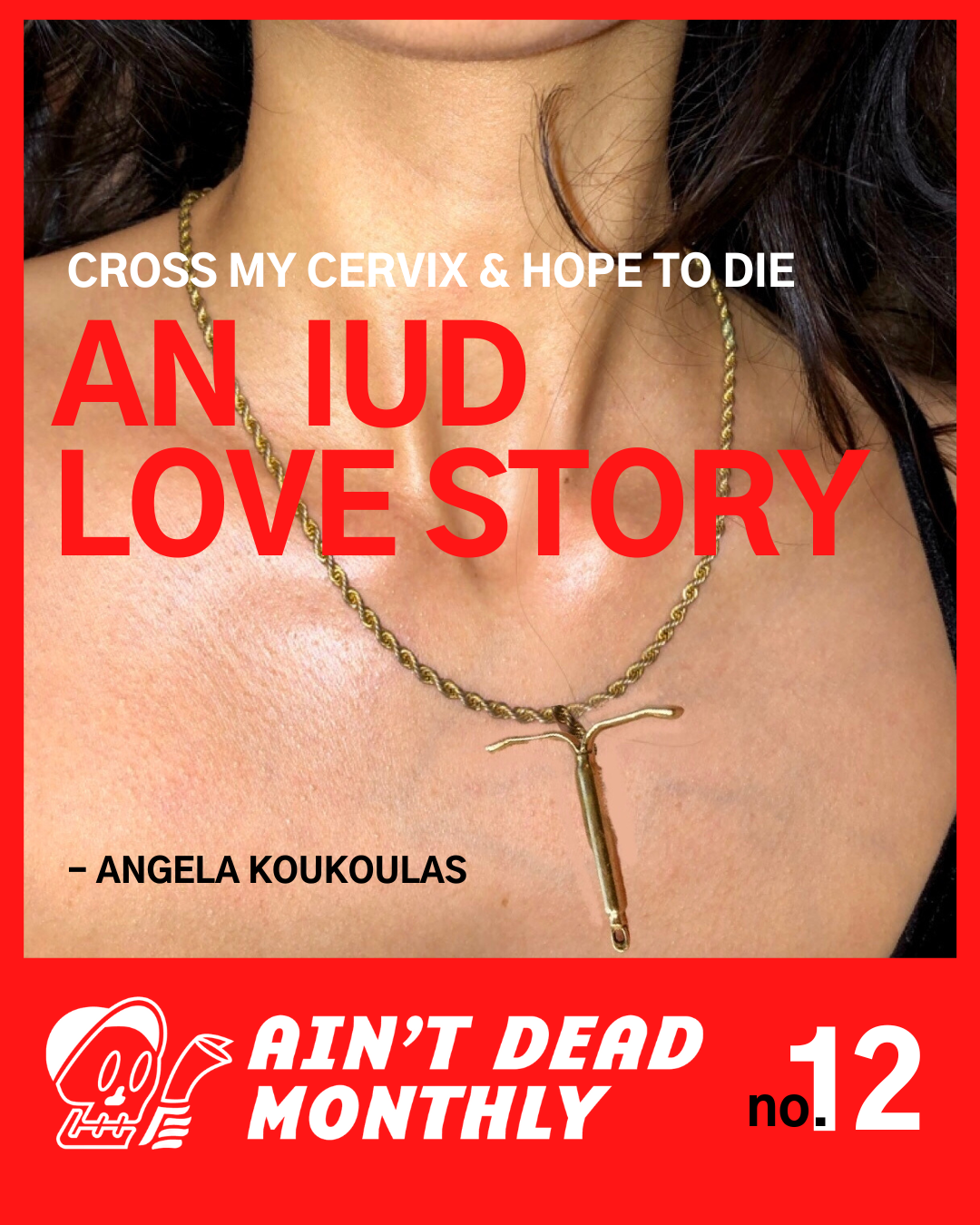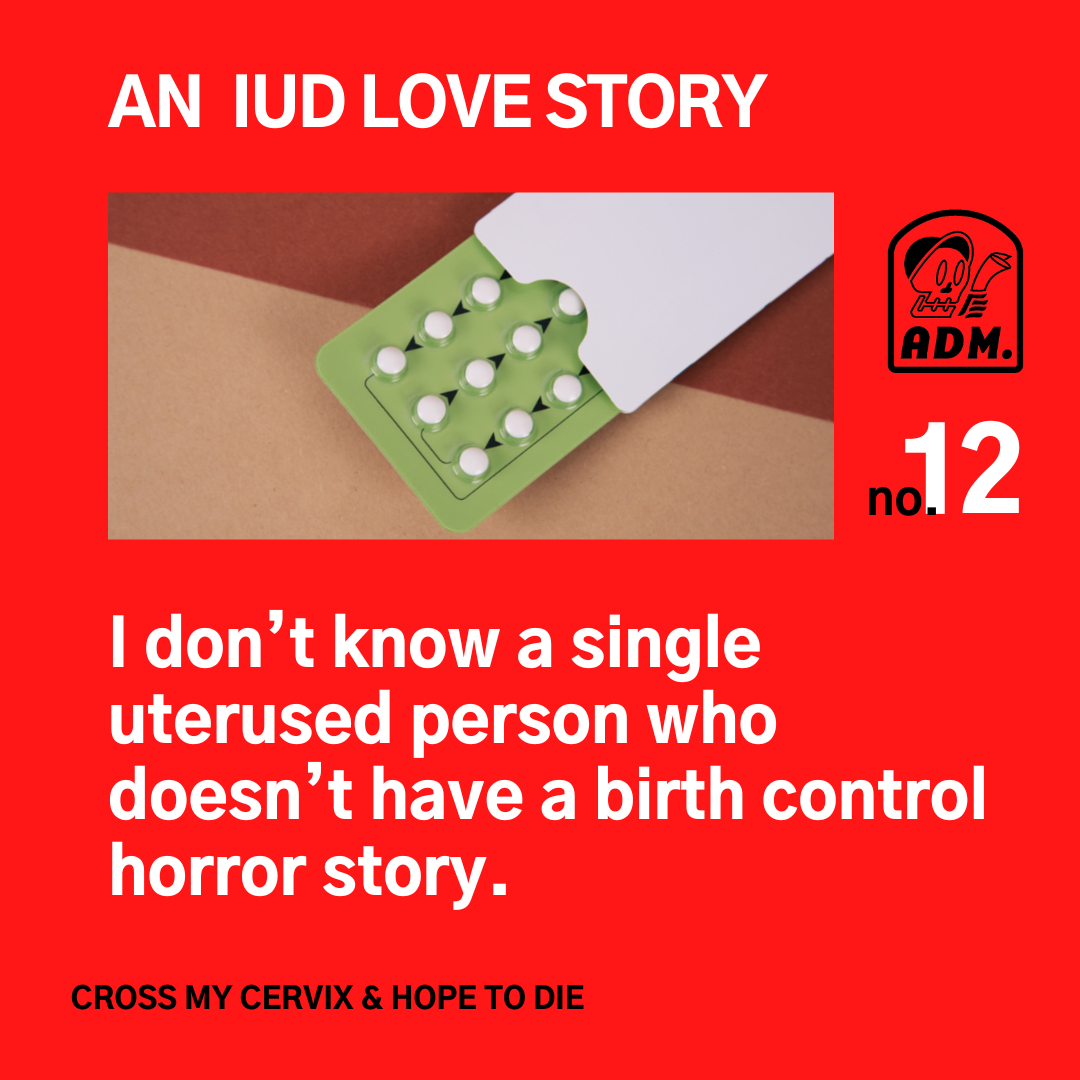
Cross my cervix and hope to die
Author: Angela Koukoulas for Ain't Dead Monthly
In the middle of the first COVID winter, I picked up my friend from her IUD insertion. Unable to go inside the doctor's office, I kicked rocks around the parking lot for 90 minutes, wondering what the hell was taking her so long; I thought it was supposed to be a grab-and-go arrangement. After a slew of unanswered calls and texts, I called the front desk to make sure I was in the right place. They confirmed, and a few minutes later my friend shuffled out looking half-hungover and half-shell-shocked. She told me what happened–it was the worst pain of her life; she passed out in the office and needed me to drive home fast.
Secretly, I was pissed that I sat in a parking lot for two hours to cart her dramatic low-pain-tolerance ass back home (and apparently we wouldn't be stopping for ice cream), but as fate would have it, three months later I was driving myself home from the same office, trying not to pass out from the worst pain of my life.
I don’t know a single uterused person who doesn’t have a birth control horror story. It’s why I was interested in the low-maintenance option of the IUD. Unlike the pill which is taken orally daily, and processed throughout the entire body in its pursuit of reaching the reproductive system, the IUD’s hormones are supposed to be localized in the uterus. The IUD sits in the cervix and releases progesterone to stop ovulation and fertilization. It is one of the most effective forms of birth control with 99% effectiveness, compared to the patch and pill which are both 93% effective (Planned Parenthood says that “Only 9 out of 100 people will get pregnant each year” with these methods). That still feels like a lot of people.
I learned all of this in my online research and during two pre-procedure conversations with doctors. Once over a Planned Parenthood telehealth visit and once at the office where I had my insertion. I was plainly told to prepare for “some discomfort” and to take 400mg of ibuprofen prior to my appointment.
The instructions were simple enough, so I went to my appointment armed with 400 mgs of ibuprofen and the assumption that I’d be in and out in 30 minutes.
The appointment went as such: I was called into the office, met the nurse, and got a pap smear (kinda hurt). Then the nurse prepared her tools and said I might “feel a pinch” as she counted down from 10.
What I actually felt was more like a taser to the cervix. I remember nothing beyond my entire body feeling stunned–like getting hit by a truck, but only for a few seconds. About 10 seconds later, my nurse said, “all done, no babies for five years!”
The next thing I remember is fainting and convulsing myself awake in the empty doctor's office. The nurse left just before I blacked out. I was in so much pain, too much to move. At some point, an employee wandered in and said, “you’re still here?” She made sure I was ok and left the room to grab my insertion nurse, a heating pad, and a chocolate bar (thanks queen).
Two hours passed by and I was still in too much pain to stand. After coming to the medical conclusion that I was not making a miraculous recovery anytime soon, the nurse worried that the IUD may have perforated my cervix and told me I needed a transvaginal ultrasound. Already feeling a little traumatized, I was not thrilled at the idea of sending an 8-inch Harry Potter Wand to the frontlines.
After some concerning but ultimately unclear dialogue between the nurse and the ultrasound tech, they sent the ultrasound off for a second opinion and cleared me to go to my car and drive home. Please note: Don't IUD and drive. The second I got to my car, my reproductive organs remembered they were in a three-car pileup and the pain started all over again. A 10-minute drive became an Odyssey of rolling windows down, turning the music up, and keeping myself distracted so I wouldn’t faint again.

When I finally got to my apartment, I was treated to the hellscape of navigating eight hours of my IUD trying to weasel its way out of my cervix. Without any real medical advice, I took six liver-destroying ibuprofen and curled into a ball with a heating pad. I received a call from the nurse who said they placed it too high (whoopsie!) and I would need to go to the ER if it cramped out. I asked how I would know if it was cramping out, and she said “oh, you’ll know.”
That was the extent of my medical advice. No one seemed to have answers for me and so I waited to either feel better or feel my IUD slither out.
Amid the suffering, my friend visited me like a ghost in “A Christmas Story.” She saw me writhing in pain, and whispered “you did this to yourself” before kissing me on the forehead.
Left to my own devices with a growing sense of guilt, I took an edible and contacted every single person I knew with an IUD. First, there was a moment of biblical reckoning with the girl I drove home a few months before. She said it was the best decision she ever made. Then I spoke with another friend who was actually on her 2nd IUD. Her first one (the copper ParaGuard) cramped out and was replaced with a Mirena, which was also removed after causing painful periods every 14 days. In her veteran opinion, that was probably not going to happen to me. She was right, and within 24 hours I was back to 100%.
In the coming days, I would exchange horror stories with more friends who secretly had IUDs the entire time! A few landed on IUDs after other horrific birth control experiences, finding it the lesser of evil man-made contraceptives. The arm implant made one friend feel emotionally flat for an entire year, saying “I didn’t even want to have sex anymore, what’s the point?” The pill made a few feel depressed, gain weight, lose hair, the whole bit. Another friend bled for two months straight after her IUD insertion.
The internet is full of even scarier, more brutal, accounts of birth control effects. This is contrasted by the clean professional and minimizing language on medical websites. See Planned Parenthood’s language on IUD insertion, “Some people feel cramps or pain, but it doesn't last long and medicine can help.” This is essentially what I was told during consultations, and so I was underprepared for the level of pain and trauma I would experience. When I came to after blacking out in the doctor’s office, the nurse had to “ask around” to try and find some more ibuprofen for me, but wouldn't give any to me since I took two earlier. They offered no other solutions for me.
I’m not in the minority of patients who experience extreme pain at insertion, and I’m not the first to wonder why I would receive more pain management if I were doing something as simple as getting lip fillers. Offices have financial incentives to keep insertion as an in-office procedure, rather than involving an operating room and anesthesiologist. As a whole, the medical field (and maybe the whole world) is unsympathetic to reproductive pain. A 2021 Washington Post article exposed the American medical field’s history of birth control to include eugenics, white supremacy, illegal testing on Black and Brown women, and currently, a reversal of abortion access. With a reputation so poor, it’s no wonder we must seek information from our trusted friends and community.
I love having an IUD; it was worth the pain, and I’ll get another one in three years. It stopped my periods completely and I feel so much more in control of my health. I went above and beyond to prepare for an IUD, but I was never given a reason to expect uterine trench warfare. When I was laying in the doctor’s office, I wondered if I somehow deserved the pain for going against biology, maybe I did “do it to myself”. After 2 years of radical reflection, I know I deserved proper care at every level: accurate information from my doctors, significant pain management, and aftercare that goes beyond a phone call 🪦
Angela is both funny and beautiful. Her hobbies include oversharing and staring at the wall. She is legally 5’5”.
